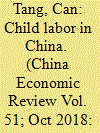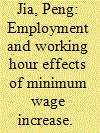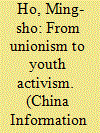| Srl | Item |
| 1 |
ID:
161878


|
|
|
|
|
| Summary/Abstract |
We present the first systematic study on child labor in China. Child labor is not a negligible social phenomenon in China; about 7.74% of children aged from 10 to 15 were working in 2010, and they worked for 6.75 h per day on average, and spent 6.42 h less per day on study than other children. About 90% of child laborers were still in school and combined economic activity with schooling. Our results show that child labor participation is positively associated with school dropout rate. A child living in a rural area is more likely to work. Compared with place of residence, the gender of a child are less important. The educational level of the household head and its interaction with the gender of the household head seem to be unimportant. However, household assets per capita and household involvement in non-agricultural activities are negatively related to the incidence of child labor. A child from a household with more adults is less likely to work. The prevalence of child labor in China exhibits significant regional variations. The child labor incidence is correlated with the development level of each region: the Western region has the highest percentage of child labor, followed by the Eastern and Central regions.
|
|
|
|
|
|
|
|
|
|
|
|
|
|
|
|
| 2 |
ID:
130981


|
|
|
|
|
| Publication |
2014.
|
| Summary/Abstract |
Using a difference-in-differences model, the present paper provides empirical evidence of minimum wage effects on employment and working hours in China. The results show that male employment is not affected by a minimum wage increase, although men's working hours do increase. In contrast, female employment is more likely to be negatively affected by a minimum wage increase, while their working hours remain unchanged. This may lead to women being in a more disadvantaged position in the workforce, and adopting a monthly minimum wage may induce firms to extend men's working hours. Therefore, to better protect disadvantaged workers, we suggest that minimum wage regulation should focus on the target group of less-educated women, and that a unified minimum hourly wage needs to be set for both full-time and part-time workers. Meanwhile, the importance of human capital accumulation should be addressed in alleviating the negative effects of minimum wage increases.
|
|
|
|
|
|
|
|
|
|
|
|
|
|
|
|
| 3 |
ID:
175163


|
|
|
|
|
| Summary/Abstract |
This article examines two major protests related to working-hour reforms in Taiwan in 2000 and 2016–18, paying particular attention to the shift in the composition of protesters from union members to youth activists. The decline in mass membership and the failure to consolidate a national federation have diminished the political presence of labour unions. The emergence of youth protest movements, both before and after the 2014 Sunflower Movement, made possible the advent of Taiwan’s youth as political actors. The reconfiguration of Taiwan’s working hour politics has paralleled the global transition from the classical organization-based collective action to the digitally enabled ‘connective action’. The concluding section provides reflections on the impacts as well as the limitations of this newer form of labour politics.
|
|
|
|
|
|
|
|
|
|
|
|
|
|
|
|